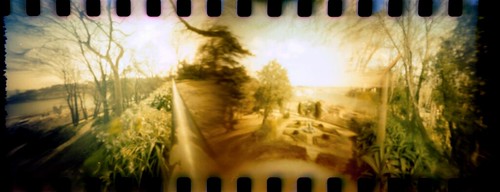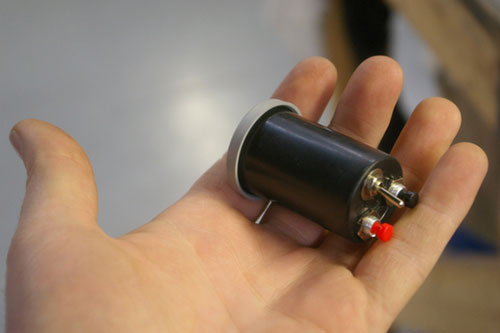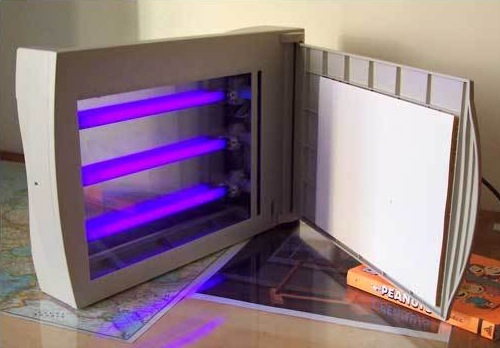Check out this monster 16×36-inch view camera that Ron Klein built for a friend.
Category: Camera Hacking & DIY
DIY back-lit photo lightbox for under $10
My client loved the way photos & images look when back-lit but could not
afford the high price of a modern and ultra thin lighbox. I will reveal
how a 4×6 up to a 8×10 photo or document viewing lightbox system is
created for only $8usd in materials…
Paul Beard’s homemade Holgaroid
Check out Paul Beard‘s sweet DIY Holgaroid (Holga + Polaroid) made of the guts of a Polaroid EE100 and foamcore! He writes:
This project has been brewing for quite a while, but came to a full boil when I got gifted with a couple of boxes of Polapan from Bre Pettis, MAKEr extraordinaire.
The camera was a gift from him as well, and I have regretted disassembling it for quite some time (it worked fine but the pictures were pretty ordinary. So it got chopped up).
There are Polaroid backs for Holgas but they cost money, something I have very little of. I do have time and I’m not afraid to fail, so some foamcare, some glue, a fair amount of backing paper from 120 film rolls (not sticky or stretchy like tape, and it’s light-proof) and I made a box to put the lens at the right distance.
So far pictures have been tough to get, as the days have not been terribly bright and 80 ISO film @ 1/100 second is a bit challenging.
But I’ll get some.
More photos of the camera in his Homebrew Holgaroid set in his photoblog on Flickr.
DIY Diana flash trigger
Check out photographer Don Brice‘s excellent modification that allows you to use normal flash/strobe units on Diana toy cameras:
I enjoy using the Diana in the studio and shooting portraits and still life lit with flash. I discovered long ago that by ripping off the usual connector on the end of the syncro cable, you could bare the two wires and jam them down the two flash sockets on the Diana-F model. Ta-da. Plug the other in to your strobes and away you go…
Continue reading instructions at Brice’s blog, Blurry Thinking.
Homemade multiple-aperture pinhole "blender" camera
Another killer from bricolage.108, the man who brought us the outstanding double-sided lens and pinhole bi-cam and DIY half-frame camera mods! This one’s a three-aperture, curved film plane pinhole camera, which is a homemade version of the Pinhole Blender.
Step-by-step instructions with plenty of illustrative photos here at bricolage.108’s blog. Nice work, again!
Cristal Blend by bricolage.108. More photos he made with this camera here on Flickr.
How to make Pentax DSLR cable shutter release from a hands-free cell phone kit
Eagleapex writes:
I’m trying to get into HDR photography, which usually requires some very long exposure shots. The best way to do this is with a tripod and a shutter release. I got the tripod off Craigslist, but the shutter release was too expensive for me, so I set off to make my own. This is inspired by this tutorial for a Canon DSLR.
Read instructions at Instructables
Photo by Eagleapex, under the Creative Commons Attribution Share Alike license
Lens hacking article: "Hand-Assembling Lenses for the View Camera"
Check out photographer John Siskin‘s article on building your own multi-element, soft-focus lenses out of diopters. The article originally ran in View Camera Magazine and has heaps of example photos. You can download a PDF reprint of the article directly from Siskin.
Thanks to Katie Cooke for the heads-up!
Related: I ordered and received a copy of John Evans’ new ebook, Exploring Simple Lenses (blogged previously). I’m making my way through it, look for a review soon!
How to re-spool 120 film onto 620 spools
Glenn E. Stewart shows you how to re-spool 120 film onto 620 spools so you can keep shooting those older cameras. Excellent instructions with photos of each step.
He’s got good info on other photographic topics on the rest of his Web site, too!
Ross Orr’s homemade pinhole camera in MAKE
Ross Orr‘s sweet home-built 9×12, curved film plane pinhole camera is featured in the current issue (#9) of MAKE Magazine.
Don’t miss the annotated photo of the camera on Flickr!
Dead flatbed scannner housing for UV light source
Check out Instructables member 5Volt‘s design for using the chassis of a dead flatbed scanner as a housing for a UV light source. This was conceived for making printed circuit boards, but you could just as easily use it for alternative process printing.
Read instructions at Instructables





